| Weight | 1 lbs |
|---|---|
| Dimensions | 9 × 5 × 2 in |
| host | mouse |
| isotype | IgG |
| clonality | monoclonal |
| concentration | concentrate, predilute |
| applications | IHC |
| reactivity | human |
| available size | 0.1 mL, 0.5 mL, 1 mL concentrated, 7 mL prediluted |
rabbit anti-p21WAF1 monoclonal antibody (ZR288) 6307
Price range: $160.00 through $528.00
Antibody summary
- Rabbit monoclonal to p21WAF1
- Suitable for: Immunohistochemistry (formalin-fixed, paraffin-embedded tissues)
- Reacts with: Human
- Isotype:IgG
- Control: Colon carcinoma
- Visualization: Nuclear
- 0.1, 0.5, 1.0 mL concentrated, 7 mL prediluted
rabbit anti-p21WAF1 monoclonal antibody ZR288 6307
| target relevance |
|---|
| Protein names Cyclin-dependent kinase inhibitor 1 (CDK-interacting protein 1) (Melanoma differentiation-associated protein 6) (MDA-6) (p21) |
| Gene names CDKN1A,CDKN1A CAP20 CDKN1 CIP1 MDA6 PIC1 SDI1 WAF1 |
| Protein family CDI family |
| Mass 18119Da |
| Function FUNCTION: Plays an important role in controlling cell cycle progression and DNA damage-induced G2 arrest (PubMed:9106657). Involved in p53/TP53 mediated inhibition of cellular proliferation in response to DNA damage. Also involved in p53-independent DNA damage-induced G2 arrest mediated by CREB3L1 in astrocytes and osteoblasts (By similarity). Binds to and inhibits cyclin-dependent kinase activity, preventing phosphorylation of critical cyclin-dependent kinase substrates and blocking cell cycle progression. Functions in the nuclear localization and assembly of cyclin D-CDK4 complex and promotes its kinase activity towards RB1. At higher stoichiometric ratios, inhibits the kinase activity of the cyclin D-CDK4 complex. Inhibits DNA synthesis by DNA polymerase delta by competing with POLD3 for PCNA binding (PubMed:11595739). Negatively regulates the CDK4- and CDK6-driven phosphorylation of RB1 in keratinocytes, thereby resulting in the release of E2F1 and subsequent transcription of E2F1-driven G1/S phase promoting genes (By similarity). {ECO:0000250|UniProtKB:P39689, ECO:0000269|PubMed:11595739, ECO:0000269|PubMed:8242751, ECO:0000269|PubMed:9106657}. |
| Subellular location SUBCELLULAR LOCATION: Cytoplasm {ECO:0000269|PubMed:11463845}. Nucleus {ECO:0000269|PubMed:11463845, ECO:0000269|PubMed:23213251}. |
| Tissues TISSUE SPECIFICITY: Expressed in all adult tissues, with 5-fold lower levels observed in the brain. |
| Structure SUBUNIT: Interacts with HDAC1; the interaction is prevented by competitive binding of C10orf90/FATS to HDAC1 facilitating acetylation and protein stabilization of CDKN1A/p21 (By similarity). Interacts with MKRN1 (PubMed:19536131). Interacts with PSMA3 (PubMed:11350925). Interacts with PCNA (PubMed:11595739, PubMed:18703516, PubMed:18794347, PubMed:8861913). Component of the ternary complex, cyclin D-CDK4-CDKN1A. Interacts (via its N-terminal domain) with CDK4; the interaction promotes the assembly of the cyclin D-CDK4 complex, its nuclear translocation and promotes the cyclin D-dependent enzyme activity of CDK4 (PubMed:9106657). Binding to CDK2 leads to CDK2/cyclin E inactivation at the G1-S phase DNA damage checkpoint, thereby arresting cells at the G1-S transition during DNA repair (PubMed:19445729). Interacts with PIM1 (PubMed:12431783). Interacts with STK11 and NUAK1 (PubMed:25329316). Interacts wih DTL (PubMed:23213251). Interacts with isoform 1 and isoform 2 of TRIM39 (PubMed:23213251). Interacts with PKP3; the interaction sequesters CDKN1A to the cytoplasm thereby repressing its role as an inhibitor of CDK4- and CDK6-driven RB1 phosphorylation (By similarity). {ECO:0000250|UniProtKB:P39689, ECO:0000269|PubMed:11350925, ECO:0000269|PubMed:11595739, ECO:0000269|PubMed:12431783, ECO:0000269|PubMed:18703516, ECO:0000269|PubMed:18794347, ECO:0000269|PubMed:19445729, ECO:0000269|PubMed:19536131, ECO:0000269|PubMed:23213251, ECO:0000269|PubMed:25329316, ECO:0000269|PubMed:8861913, ECO:0000269|PubMed:9106657}. |
| Post-translational modification PTM: Phosphorylation of Thr-145 by Akt or of Ser-146 by PKC impairs binding to PCNA. Phosphorylation at Ser-114 by GSK3-beta enhances ubiquitination by the DCX(DTL) complex. Phosphorylation of Thr-145 by PIM2 enhances CDKN1A stability and inhibits cell proliferation. Phosphorylation of Thr-145 by PIM1 results in the relocation of CDKN1A to the cytoplasm and enhanced CDKN1A protein stability. UV radiation-induced phosphorylation at Thr-80 by LKB1 and at Ser-146 by NUAK1 leads to its degradation. {ECO:0000269|PubMed:10753973, ECO:0000269|PubMed:11463845, ECO:0000269|PubMed:12431783, ECO:0000269|PubMed:16982699, ECO:0000269|PubMed:18794347, ECO:0000269|PubMed:20307683, ECO:0000269|PubMed:25329316}.; PTM: Ubiquitinated by MKRN1; leading to polyubiquitination and 26S proteasome-dependent degradation. Ubiquitinated by the DCX(DTL) complex, also named CRL4(CDT2) complex, leading to its degradation during S phase or following UV irradiation. Ubiquitination by the DCX(DTL) complex is essential to control replication licensing and is PCNA-dependent: interacts with PCNA via its PIP-box, while the presence of the containing the 'K+4' motif in the PIP box, recruit the DCX(DTL) complex, leading to its degradation. Ubiquitination at Ser-2 leads to degradation by the proteasome pathway. Ubiquitinated by RNF114; leading to proteasomal degradation. {ECO:0000269|PubMed:15226418, ECO:0000269|PubMed:23213251}.; PTM: Acetylation leads to protein stability. Acetylated in vitro on Lys-141, Lys-154, Lys-161 and Lys-163. Deacetylation by HDAC1 is prevented by competitive binding of C10orf90/FATS to HDAC1 (By similarity). {ECO:0000250}. |
| Domain DOMAIN: The PIP-box K+4 motif mediates both the interaction with PCNA and the recruitment of the DCX(DTL) complex: while the PIP-box interacts with PCNA, the presence of the K+4 submotif, recruits the DCX(DTL) complex, leading to its ubiquitination.; DOMAIN: The C-terminal is required for nuclear localization of the cyclin D-CDK4 complex. |
| Target Relevance information above includes information from UniProt accession: P38936 |
| The UniProt Consortium |
Data
 |
| Human colon adenocarcinoma stained with anti- p21 antibody using peroxidase-conjugate and DAB chromogen. Note the nuclear staining of tumor cells. |
Publications
| pmid | title | authors | citation |
|---|---|---|---|
| We haven't added any publications to our database yet. | |||
Protocols
| relevant to this product |
|---|
| IHC |
Documents
| # | SDS | Certificate | |
|---|---|---|---|
| Please enter your product and batch number here to retrieve product datasheet, SDS, and QC information. | |||
Only logged in customers who have purchased this product may leave a review.
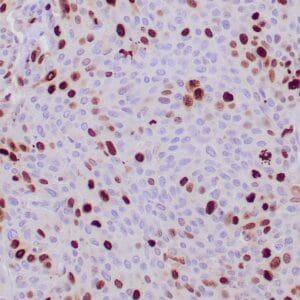
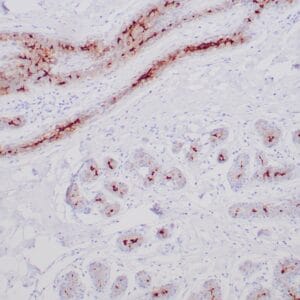
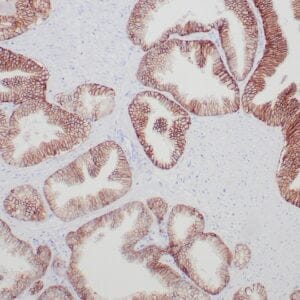

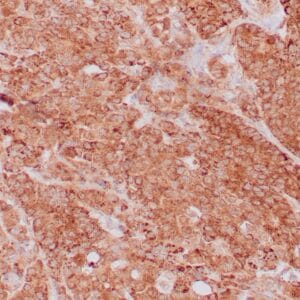
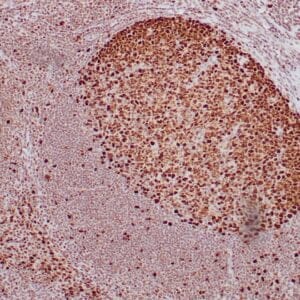

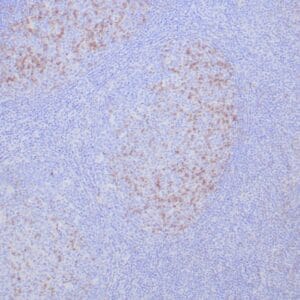
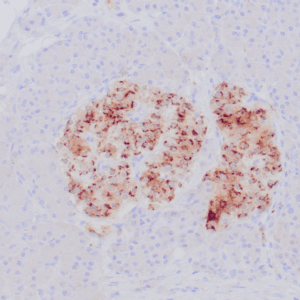
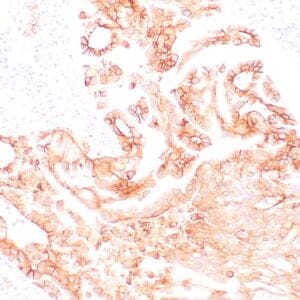
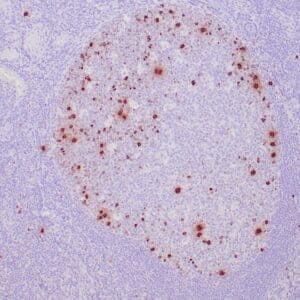
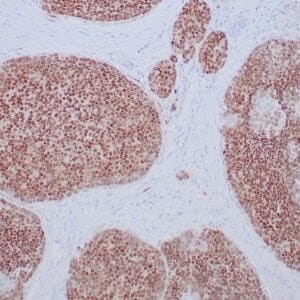
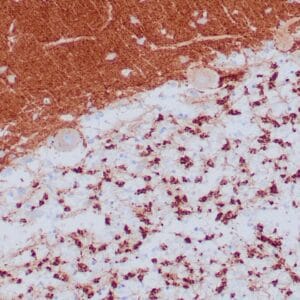
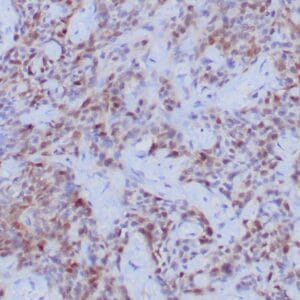
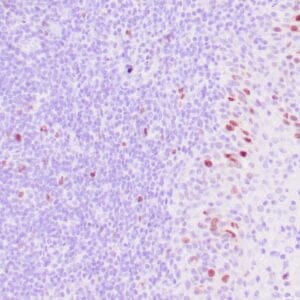
Reviews
There are no reviews yet.